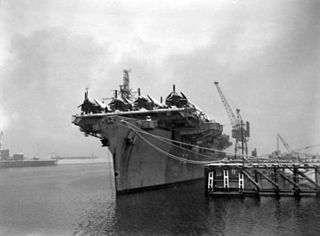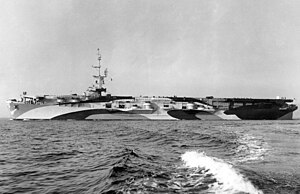The escort carrier or escort aircraft carrier, also called a "jeep carrier" or "baby flattop" in the United States Navy (USN) or "Woolworth Carrier" by the Royal Navy, was a small and slow type of aircraft carrier used by the Royal Navy, the Royal Canadian Navy, the United States Navy, the Imperial Japanese Navy and Imperial Japanese Army Air Force in World War II. They were typically half the length and a third the displacement of larger fleet carriers, slower, more-lightly armed and armored, and carried fewer planes. Escort carriers were most often built upon a commercial ship hull, so they were cheaper and could be built quickly. This was their principal advantage as they could be completed in greater numbers as a stop-gap when fleet carriers were scarce. However, the lack of protection made escort carriers particularly vulnerable, and several were sunk with great loss of life. The light carrier was a similar concept to the escort carrier in most respects, but was fast enough to operate alongside fleet carriers.

USS Takanis Bay (CVE-89) was a Casablanca-class escort carrier of the United States Navy, which served during World War II. She was named after Takanis Bay on the west side of Yakobi Island in Alaska. Launched in March 1944 and commissioned in April, she served as a carrier training vessel, operating off of San Diego. Following the end of hostilities, she repatriated troops from the Pacific theater as part of Operation Magic Carpet.

The Casablanca-class escort carrier was a series of escort carriers constructed for the United States Navy during World War II. They are the most numerous class of aircraft carriers ever built. Fifty were laid down, launched and commissioned within the space of less than two years – 3 November 1942 through to 8 July 1944. These were nearly one third of the 143 aircraft carriers built in the United States during the war. Despite their numbers, and the preservation of more famous and larger carriers as museums, none of these modest ships survive today. Five were lost to enemy action during World War II and the remainder were scrapped.

USS Casablanca (AVG/ACV/CVE-55) was the first of fifty Casablanca-class escort carriers built for the United States Navy during World War II. She was named after the Naval Battle of Casablanca, conducted as a part of the wider Operation Torch, which pitted the United States Navy against the remnants of the French Navy controlled by Vichy France. The American victory cleared the way for the seizure of the port of Casablanca as well as the Allied occupation of French Morocco. The ship was launched in April 1943, commissioned in July, and served as a training and transport carrier throughout the war. Postwar, she participated in Operation Magic Carpet, repatriating U.S. servicemen from throughout the Pacific. She was decommissioned in June 1946, when she was mothballed in the Atlantic Reserve Fleet. She was sold for scrap in April 1947.

USS Barnes (AVG-20/ACV-20/CVE-20) was a Bogue-class escort carrier in the United States Navy. She was the second ship to carry the name.

HMS Patroller was an escort carrier in the Royal Navy during the Second World War. Laid down in 1942 at the Seattle-Tacoma Shipbuilding company, she was originally named USS Keweenaw (CVE-44). USS Keweenaw was an escort carrier laid down under Maritime Commission contract by Seattle-Tacoma Shipbuilding of Tacoma, Washington, 27 November 1942; launched 6 May 1943; sponsored by Mrs. R. G. Risley; assigned to the United Kingdom 10 June 1943; reclassified CVE-44 on 15 July 1943; and transferred to the United Kingdom under lend-lease 22 October 1943.

The USS Perdido (CVE-47) was a Bogue-class escort carrier laid down as ACV-47 under Maritime Commission contract by Seattle-Tacoma Shipbuilding of Tacoma, Washington, 1 February 1943; launched 16 June 1943; sponsored by Mrs. H. M. Bemis, reclassified as CVE-47 on 15 July 1943; and completed at the Commercial Iron Works, Portland, Oregon.

HMS Ruler was the lead ship of her class of escort carrier of the Royal Navy during the Second World War. She was built in the United States as the Bogue-class carrier St. Joseph (AVG/CVE/ACV-50) for Lend-Lease to the United Kingdom.

USS St. Simon (CVE-51), an escort aircraft carrier originally classified as an auxiliary aircraft carrier, was laid down on 26 April 1943 at Tacoma, Washington, by the Seattle-Tacoma Shipbuilding Corporation, under a Maritime Commission contract ; reclassified as an escort aircraft carrier, CVE-51, on 15 July 1943; launched on 9 September 1943; sponsored by Mrs. R. H. Lewis, the wife of Major General R. H. Lewis, Commanding General, Northwestern Sector, Fort Lewis, Washington; assigned to the Commercial Iron Works, Portland, Oregon, for the completion of construction; and delivered to the Royal Navy, under lend-lease, on 31 December 1943.

USS Vermillion (CVE-52) was laid down on 10 May 1943 by the Seattle-Tacoma Shipbuilding Corporation as a Bogue-class auxiliary aircraft carrier; redesignated an escort aircraft carrier, on 10 June 1943; assigned to the United Kingdom under Lend-Lease on 23 June 1943; launched on 27 September 1943; and accepted by Britain on 20 January 1944.

USS Winjah (CVE-54), was a Bogue-class escort carrier of the United States Navy, leased to the Royal Navy during World War II.

USS Roi (CVE-103) was a Casablanca-class escort carrier of the United States Navy. She was named after the Battle of Roi, in which the United States captured the island of Roi-Namur. Built for service during World War II, the ship was launched in June 1944, commissioned in July, and acted as a transport and as a replenishment carrier. During the latter months of the war, she provided aircraft and supplies to the Fast Carrier Task Force, continuing until the end of the war. Postwar, she participated in Operation Magic Carpet. She was decommissioned in May 1946, and she was sold for scrapping in December.

USS Matanikau (CVE-101) was a Casablanca-class escort carrier of the United States Navy. She was named after the Actions along the Matanikau, a series of engagements during the Guadalcanal campaign. Built for service during World War II, the ship was launched in May 1944, and commissioned in June, and served as a training and transport carrier. Notably, some 1,332 aviators earned their qualifications on-board the carrier. Postwar, she participated in Operation Magic Carpet. She was decommissioned in October 1946, when she was mothballed in the Pacific Reserve Fleet. Ultimately, she was sold for scrapping in July 1960.

USS Tinian (CVE-123) was a Commencement Bay-class escort carrier of the United States Navy. Ordered and constructed during World War II, Tinian never entered active service and was assigned to the Pacific Reserve Fleet, Tacoma after being completed. In June 1955, the ship was reclassified a helicopter carrier and in May 1959, a cargo ship and aircraft ferry. The ship remained in reserve for her entire career and was struck from the Naval Vessel Register on 1 June 1970 and sold for scrap.

USS Mindoro was a Commencement Bay-class escort carrier of the United States Navy. The ship was a converted oil tanker, and she had a capacity to carry up to thirty-three aircraft. She was built during World War II, but was completed too late to see action during the conflict. She nevertheless saw service with the 8th Fleet in the late 1940s and early 1950s in the Atlantic Ocean. She also made two deployments to the Mediterranean Sea, in 1950 and 1954, before being decommissioned in January 1955 and assigned to the Atlantic Reserve Fleet. She was retained for just four years before being struck from the naval register in December 1959 and thereafter scrapped.

USS Point Cruz (CVE-119) was a Commencement Bay-class escort carrier of the United States Navy. Originally named Trocadero Bay until 5 June 1944 when it was renamed after the Honiara suburb Point Cruz, which was an important location during the Guadalcanal Campaign. She was laid down on 4 December 1944 by Todd Pacific Shipyards Incorporated, Tacoma, Washington; launched on 18 May 1945, sponsored by Mrs. Earl R. DeLong; and commissioned on 16 October 1945.

USS Kwajalein (CVE-98) was the forty-fourth of fifty Casablanca-class escort carriers built for the United States Navy during World War II. She was named after the Battle of Kwajalein, in which American forces captured Kwajalein Atoll. The ship was launched in May 1944, commissioned in June, and served in support of the Philippines campaign. Later in the war, she served as a replenishment carrier, during which she was damaged by Typhoon Cobra. Postwar, she participated in Operation Magic Carpet, repatriating U.S. servicemen from throughout the Pacific. She was decommissioned in May 1946, when she was mothballed in the Pacific Reserve Fleet. Ultimately, she was sold for scrapping in January 1961.

USS Sargent Bay (CVE-83) was a Casablanca-class escort carrier of the United States Navy. She was named after Sargent Bay, located within Revillagigedo Island, and was built for service during World War II. Launched in January 1944, and commissioned in March 1944, she served in support of the Invasion of Iwo Jima and the Battle of Okinawa. Postwar, she participated in Operation Magic Carpet. She was decommissioned in June 1946, when she was mothballed in the Atlantic Reserve Fleet. Ultimately, she was sold for scrapping in July 1959.

The Seattle-Tacoma Shipbuilding Corporation was an American corporation which built escort carriers, destroyers, cargo ships and auxiliaries for the United States Navy and merchant marine during World War II in two yards in Puget Sound, Washington. It was the largest producer of destroyers (45) on the West Coast and the largest producer of escort carriers of various classes (56) of any United States yard active during World War II.


















